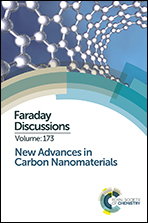Do we need covalent bonding of Si nanoparticles on graphene oxide for Li-ion batteries?
Abstract
In this manuscript, we report our investigation of anode materials for Li-ion batteries based on silicon–graphene oxide composites. Previous reports in the literature on silicon–graphene oxide (GO) composites as anodes have shown a large discrepancy between the electrochemical properties, mainly capacity and coulombic efficiency. In our research, the surface chemistry of Si nanoparticles has been functionalized to yield a chemical bond between the Si and GO, a further annealing step yields a Si–reduced GO (Si–rGO) composite while controlled experiments have been carried on mechanical mixing of GO and Si. For all samples, including a simple mixing of Si nanoparticles and GO, a high specific capacity of 2000 mA h gSi−1 can be achieved for 50 cycles. The main difference between the samples can be observed in terms of coulombic efficiency, which will determine the future of these composites in full Li-ion cells. The Si–rGO composite shows a very low capacity fading and a coulombic efficiency above 99%. Furthermore, the Si–rGO composite can be cycled at very high rate to 20 C (charge in 3 minutes).
- This article is part of the themed collection: New Advances in Carbon Nanomaterials

 Please wait while we load your content...
Please wait while we load your content...